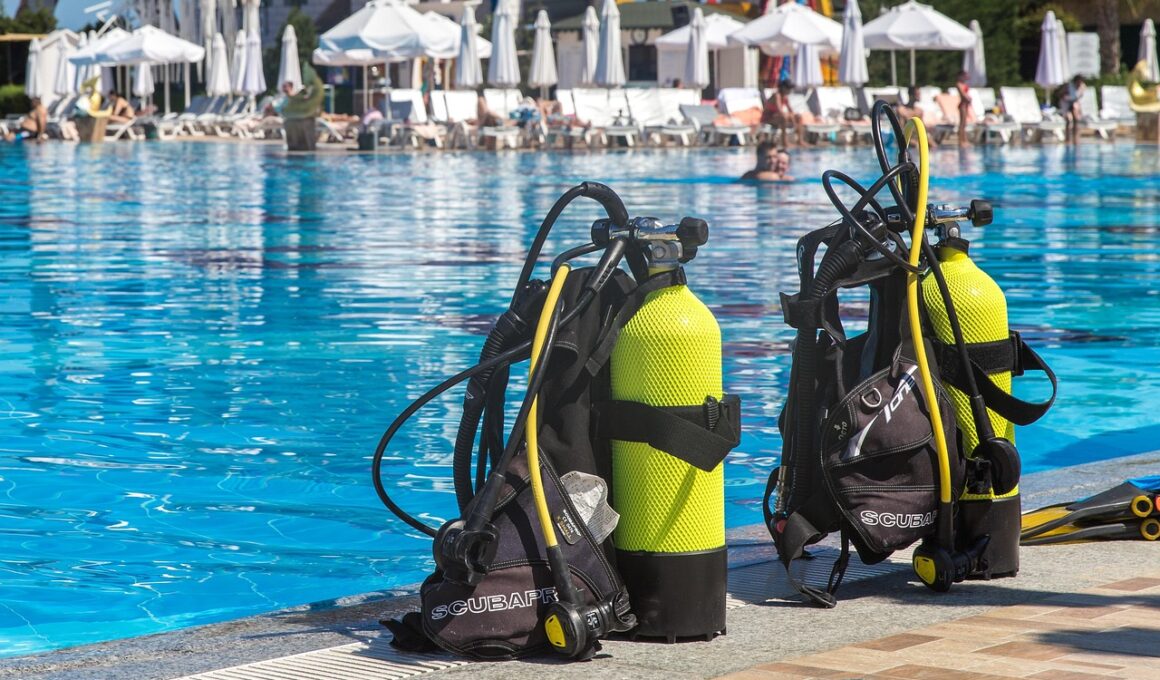Using Technology to Enhance Diving Training Sessions
In the realm of competitive diving, technology has reshaped training methodologies significantly. Coaches now utilize advanced tools that provide precise feedback on divers’ techniques, enhancing performance. Wearable devices, such as smartwatches and fitness trackers, monitor physical metrics including heart rate and breathing patterns during training sessions. Moreover, underwater cameras capture vital moments of dives, enabling coaches to analyze every movement. By recording performances, coaches and athletes can review footage, focusing on areas for improvement. Such technology fosters a better understanding of body dynamics in the water, leading to refined techniques and improved scores during competitions. Utilizing software applications, data from sessions can be compiled to create customized training regimens. Athletes can visualize their performance data and keep track of improvements over time. This constant feedback loop is critical for developing a competitive edge. Furthermore, virtual reality (VR) has emerged as an innovative tool in diving coaching. It allows divers to simulate competition scenarios, honing mental preparedness without physical strain. Embracing these technological advancements is essential for modern diving training, ensuring athletes reach their full potential effectively and efficiently.
Diving coaching can benefit tremendously from biomechanics analysis, integrating technology into training routines. Biomechanics involves studying the motion of divers to enhance performance through data-driven insights. By recording divers with high-speed cameras, coaches can analyze their movements frame by frame. This offers a detailed look at factors impacting performance, such as angles, rotations, and entry techniques. It enables the identification of inefficiencies that may not be visible during live practice. The use of specialized software can process this visual data, allowing for precise manipulation of variables like velocity and acceleration. Understanding these elements can lead to injury prevention strategies as well; knowing which techniques strain the body allows divers to adapt their approach, reducing risk. Additionally, technology enables real-time feedback, providing divers immediate information on adjustments needed during training. Some coaches implement motion capture systems, translating physical movements into digital formats that reveal patterns in diving strokes. This insight allows athletes to fine-tune their technique continuously, benefitting from quick adjustments rather than waiting for post-practice reviews. Such integration of biomechanics has the potential to elevate diving performance significantly through scientifically-backed coaching methodologies.
Leveraging Video Analysis in Coaching
Video analysis has emerged as an indispensable tool in sports coaching, particularly in the context of diving. By employing various video technologies, coaches can capture and examine divers’ performances in detail. Each dive can be filmed, allowing for extensive breakdowns of technique post-performance. Utilizing software designed for sports analysis takes this a step further by allowing for slow-motion reviews, annotations, and comparative analyses against ideal performances. Coaches can highlight specific sections of a dive, illustrating areas needing improvement through visual aids. This method becomes particularly useful when discussing complex maneuvers, as visual representation clarifies the feedback process. Diverse angles can also give insight into elements that divers may overlook themselves, fostering a culture of self-awareness. As athletes review their videos, they also learn to recognize subtle changes in their performance over time. Integration of video technology promotes a collaborative environment where divers can engage actively in their learning process. Furthermore, sharing footage with other divers for group discussions enhances the collective growth of the team. Ultimately, video analysis ensures athletes work optimally towards their goals, creating a pathway for technical excellence in diving.
Another innovative approach in diving coaching involves the use of mobile applications, which facilitate training and communication between coaches and athletes. These applications can schedule training sessions, track progress, and store performance data conveniently. By having key metrics at their fingertips, divers can be more proactive about their training and improvement strategies. Some applications even feature collaborative elements, allowing divers to share their achievements and insights easily. This sense of community encourages camaraderie and support among training partners, fostering motivation through shared goals. Additionally, customized training programs can be designed and disseminated through these platforms, aligning with individual athlete needs. Incorporating educational content related to diving skills and techniques ensures consistent learning opportunities for athletes. Incorporating nutrition tracking into these apps can also be beneficial, focusing on improving fitness and recovery linked to performance. Such holistic approaches foster well-rounded athlete development. More than just tools for tracking, mobile apps encompass full support systems guiding divers through their competitive journeys. As a result, athletes no longer simply rely on traditional coaching methods but can leverage technology for a comprehensive coaching experience.
The Role of Environmental Sensors
Environmental sensors have also showcased tremendous potential in enhancing diving training sessions, offering insights previously unattainable. Instruments can measure water temperature, pressure, and even aquatic visibility—elements that directly impact a diver’s performance. Understanding these environmental variables allows divers to prepare adequately for various competitive conditions. For instance, if a competition is set in a colder climate, divers can adjust their training in advance to ensure they maintain optimal performance. Additionally, incorporating footage from dives taken in diverse environments provides valuable comparative data. This helps build adaptability in athletes, fostering the ability to excel regardless of changing conditions. Furthermore, environmental sensors can be linked with social media to share performance and experiences with broader communities. Divers may also receive weather alerts that can impact their training schedules. Such proactive measurements ensure athletes can make informed decisions leading up to events. Moreover, the integration of these technologies into training promotes a culture of preparedness that resonates throughout individual and team dynamics. As a result, the incorporation of environmental sensors represents an innovative step forward in diving coaching by creating a data-rich training environment for every athlete.
Establishing a feedback loop is crucial in diving coaching, and technology plays a vital role in its enhancement. Implementing tools that gather performance data creates a continuous stream of information. This information empowers both athletes and coaches to review and adjust training approaches in real-time. With the integration of platforms that facilitate performance tracking, progress can be measured effectively, indicating whether techniques are improving or need adjustments. Regularly assessing performance data helps in recognizing patterns indicative of success or areas needing focus. Creating a collaborative environment where feedback is encouraged fosters a growth mindset for divers. They begin to view constructive criticism as an essential tool for improvement rather than a setback. Coaches can utilize data to equip divers with the skills necessary for self-analysis—an invaluable skill set for their ongoing development. Additionally, professional development sessions can be designed using insights drawn from performance data, ensuring coaches stay ahead of the game. This data-centric approach creates a culture where divers remain motivated, striving for excellence every day. Hence, establishing effective feedback loops through technology paves the way for long-term success in diving coaching.
Conclusion: Future of Diving Coaching
Looking toward the future, the impact of technology on diving coaching seems limitless. As advancements continue, the integration of artificial intelligence could personalize training programs even further, tailoring fitness and technique regimens to each athlete’s unique needs. Innovations such as predictive analytics could disrupt traditional training methodologies, allowing coaches to foresee trends and outcomes based on historical performance data. With ongoing research and development in wearable technologies, the possibility of monitoring divers’ physiological responses will only increase, bridging gaps in understanding performance at a scientific level. Virtual reality may evolve into more immersive training experiences, simulating competition stresses and conditions without risk. Furthermore, community platforms integrated with diving data enable collaboration, fostering teams that learn together. Coaches and athletes alike can engage with extensive resources, continuously refining their skills. These developments ensure that technology will remain a cornerstone in diving coaching strategies, enhancing training experiences and promoting elite performances. As divers embrace these innovations, the sport will likely evolve quicker than ever before. Ultimately, this exciting relationship between technology and diving creates pathways that redefine athletic excellence and cultivate future champions.
Moreover, diving coaches will need to adapt continuously to harness these technological advancements. Ongoing education and training in using these tools effectively will be critical for coaches to maximize their interactive experiences with athletes. Understanding how to interpret data and translate it into actionable insights will separate successful coaches from those who do not embrace technology. As a competitive landscape evolves, the demand for tech-savvy diving coaches will increase, pushing traditional coaching methods to evolve too. Cultivating a forward-thinking approach ensures that diving remains relevant and continues to grow. Engaging in professional development opportunities allows coaches to remain competitive in an evolving landscape. Moreover, diving clubs may find it advantageous to invest in technology, emphasizing the importance of modern coaching techniques to attract new talent. Athletes will inherently benefit from this enriched training approach, leading to better performances and overall experiences. The relationship between technology and diving coaching proves crucial in creating a well-rounded athlete. As we embrace these evolving paradigms, the focus shifts towards a bright future for diving, intertwining tradition with innovation in training methodologies.


